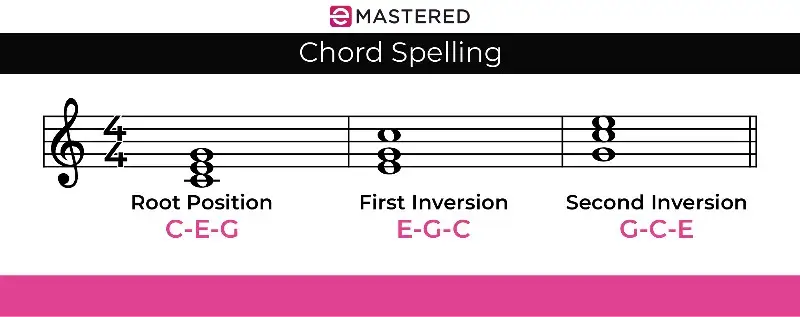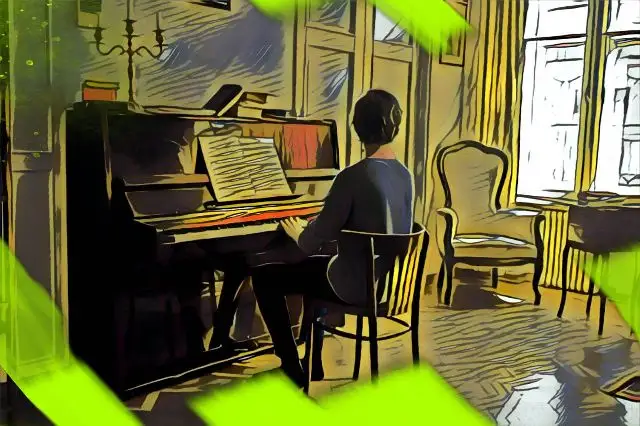Crafting killer chord progressions is key to making a strong song. Once you've learned chord basics, it's time to upgrade your skills! As it turns out, just a couple of mindful note changes can take an otherwise vanilla chord progression from drab to fab.
Below, we'll demonstrate how to use different chord voicings to build stronger chord progressions. We'll also break down how chord voicing works so that you can put all the notes to good use. Let's dive in!
What Are Chord Voicings?
Simply put, chord voicings are the various ways chords can be expressed. Voicings create the context of chords within a progression, and the added nuance can turn surface-level basic chords into something that feels more complex.
Chord Spelling: How Do We Build Chord Voicings?
For example, let's take the common chord C major. In root position (which we'll define below), this chord is expressed as C E G, in that particular order. In root position, it's assumed that each C E G note is a third apart with C as the bass note and G as the highest note tonally in the chord.
When you're playing with chord voicings, you don't necessarily make these assumptions.
We might play a C major chord as E G C or G C E. These voices each have a different voice leading (E G C is led by the third and G C E is led by the fifth), but they're technically still classified as C major chords due to sharing the same core notes and context as our original C major chord.

This is just one of the methods used to manipulate chord voicing, but just remember that individual chords can be showcased and classified in multiple ways.
When studying music theory, you'll learn that similar-sounding chords could be classified as completely different things based on the context they're placed in. Simply put, chord voicings play around with the expression of a chord to create a stronger feel within a piece of music.
What Is A Root Note?
A root note is a note that defines the name of the chord. So in C major, the root note would be C. Even if the chord was voiced as E G C or G C E, the root note would still be C since these chord inversions are defined by the root key, or C major.
Defining the root note in a chord or chord progression can help you understand the context of a particular voicing.
Chord Voicing Examples
We use chord voicings when we manipulate the shape, chord tone, or root structure of chord in order to make more cohesive chord progressions. We can understand this logically, but the best way to get a handle on different voicings is to hear them at work.
Check out this video where the pianist demonstrates the power of chord voicing:
By choosing to create a progression that has cohesive upward motion, the chord progression sounds more cohesive and intriguing to us as listeners. This is why we can create so many songs out of just seven notes in the musical alphabet! Chord progressions are repeated across generations, but the voicing of chords can vary drastically, opening up new dimensions for musical expression.
How To Create Chord Voicings: 5 Methods
So, how can you manipulate chords from their root position to create a more memorable expression? There isn't one right answer! Musicians can voice chords by changing the position of notes, playing chords across multiple octaves, adding notes onto chords, and more. Here are the five main ways you can build unique chord voicings.
Inversions
Inversions refer to changing the chord spelling or playing a chord where the root of the chord is not in home position. If we use the example of C major as discussed above, the first inversion would be expressed as E G C and the second version would be G C E.
Spacing
Spacing refers to how closed or open a chord is. Closed chords have notes that are closer together or less than an octave apart. Open chords have notes that are further away, loosely defined as more than an octave apart:
Chords played in an open position have more space and less tension than those played in a closed position. This tension and space can be harnessed to create more feeling across a progression. Hear the difference between closed and open - position chords in this example:
Chords can easily be played across different octaves. If a bass player is playing the root C note, the singer is performing a G and the guitar is playing an E, it's still a C major chord even though the bottom note is far from the top note.
Doubling
As the name suggests, doubling implies playing certain notes of a chord more than once. This technique is showcased all across music. For example, it's common for root notes to be doubled, further expressed by the bass player.
Pianists might double up notes across the left and right hands. Doubling up notes can help emphasize different chord qualities.
Extensions
Extended chords are technically different types of chords altogether, but it's key to note that using extended chords can give you more room to create unique voicings. Jazz chords are known to use common chord extensions like 7ths, 9ths, and 13ths. Just like basic triads, extended chords can be doubled, expressed as inversions, and reordered to build new voicings.
Moving Chord Tones
Adding certain notes between chords within a progression can make it easier to seamlessly transition from one chord to the next.
For instance, let's consider the common chord progression Cmaj Fmaj to Gmaj. Between chords C and F major, you might emphasize the note "E" since E is the voice leading naturally to the next note in the C major scale, F. Moving chord tones helps you move seamlessly from different positions creating a more cohesive sound.
Chord Voicing FAQ
Still struggling to grasp onto the music theory of chord voicing? Check out these frequently asked questions.
What are chord voicings?
Chord voicings refer to the different ways chords are expressed. A chord consists of multiple notes, and chord voicings refer to the various ways these notes can be arranged.
How many chord voicings are there?
While there are only a handful of notes in the musical alphabet, there are thousands of chord voicings to choose from. There is so much variation in chord expression when you experiment with inversions, leading tones, doubling and experimenting with positions.
What is a root note?
A root note is the defining note of a chord, that's usually the lowest note when a chord is expressed in root position. For instance, in C major, the "C" note is the root note since it defines the chord and is played as the low root note when played in its natural state.
Hence, chord voicings are an invaluable concept for any musician. Whether you're using intervals, doubling, different positions, or added tones, paying close attention to your voices will undoubtedly help you build better sounds. Have fun playing with your chord tones!





